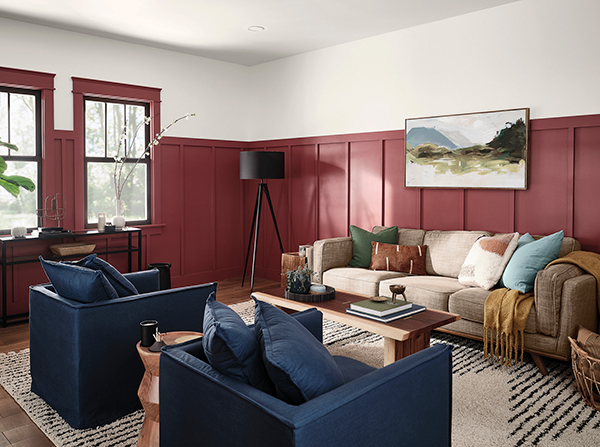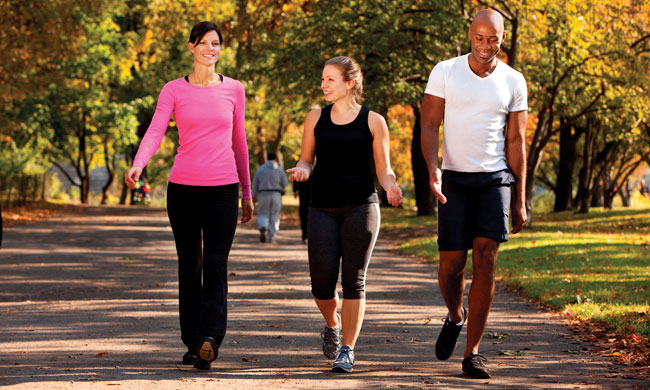HEALTHY LIVING
Healing home design can come from color


How to infuse living spaces with color that feeds the soul
(Family Features) From experiences to surroundings, the past year has brought a renewed focus on feeding the soul. In an era of overstimulation and information overload, many are finding a new appreciation for living life minimally but with maximum experiences.
That mentality is increasingly evident in all aspects of life, especially with home design and decor. After all, spending more time at home means more time to discover what truly evokes happiness.
At the same time, as the focus on physical and mental wellness heightens, design experts see those trends reflected in a more considered approach to design inspired by color therapy, which makes it possible to create beautiful spaces filled with healing color.
With an expertly coordinated color palette, like the Color Collections from HGTV Home by Sherwin-Williams, colors work in perfect harmony in any combination. Thoughtful use of color is among the most effective design tools for reveal-worthy style in your home.
Appliances
In the past, appliances were meant to blend into the decor to be less obvious, albeit essential, elements of a kitchen. A more contemporary approach: vibrant appliances that get noticed. You can find major appliances in a wide range of colors, but if you’re not sure about going that big and bold, many smaller countertop appliances, such as stand mixers and toasters, come in a range of colorful options, too.

Architecture
When contemplating where and how to apply color to a space, avoid boxing in your options. Think beyond the traditional wall space when you’re planning ways to change the color in a space; be thoughtful with color and highlight architectural details to elevate the interest and charm in your home. Take a 360-degree immersive color approach, painting the same shade from floor to ceiling and all around to create a mood-boosting lift to a room.
To infuse more color and boldness into your space, consider a timeless and elegant shade of red, like HGTV Home by Sherwin-Williams’ 2021 Color of the Year. This paint color, “Passionate,” is a deeply saturated hue that is daringly rich and invigorates the senses. This bold and empowering red is steeped in history, merging modern design with traditional charm.
Furniture
Whether you’re into project pieces you can transform into something new or simply shopping for furnishings that complement your space, be sure to consider how the furniture fits into the overall color scheme. A space isn’t defined by the color of its walls or floors alone. Selecting furniture that fits with the design brings a more cohesive and stylized feel to the room. For example, a desk and bookshelves in pale natural hues can lend warmth to an office with walls painted a cool dynamic blue.
Cabinets
Painted cabinets are on-trend, and if you’re bored with basic whites and grays, you’re not alone. Designers are going bold in the kitchen and using cabinetry as a showpiece. These color palettes create inspiring spaces that invite you to get busy baking or simply pull up a chair and linger over a cup of coffee.
If you’re concerned about how to bring a color palette together, consider using a collection that has been intentionally curated to mix and match shades for a perfect look no matter which hues you choose. You can easily achieve a new look with an option like the Delightfully Daring Color Collection from HGTV Home by Sherwin-Williams. With earthy tones inspired by nature and a dose of vibrancy, the shades are simultaneously energizing and calming. The palette makes it easy to introduce statement colors in unexpected ways so you can feel confident in your selections.
Textiles
Elements like window treatments, blankets, pillows and rugs lend important detail and character to a room, and they’re also a relatively affordable way to make noticeable changes. The key is to establish cohesion in the space so no one element is overpowering. Softer tones and natural textures can help bring balance to bold hues while vibrant shades create a colorful pop against a more neutral backdrop. To keep the balance, start with your color statement, whether it’s bold bedding in an otherwise neutral bedroom or softer shades in the accent pieces for a room with strong color applied to the decorative molding.
Incorporate Color Like a Pro
- Balance the boldness of red with soft whites and natural textures.
- Rustic reds and natural wood elements add warmth to a cool backdrop.
- An invigorating green hue pairs beautifully with brass, copper and rich wood tones.
- For a soft, monochromatic look that’s full of complexity and dimension, add layers of texture with furnishings in the same color for a 3D color look.
- Carry bold color onto ceilings for a truly immersive experience.
Explore color combinations and get inspired to bring healing design elements into your own home at hgtvhomebysherwinwilliams.com.
HEALTHY LIVING
Walk your way to better health

(Family Features) A walk is not just good for your body, it’s also good for your soul. Physical activity, like walking, is one of the best ways to reduce stress and boost your mood. However, reports show walking rates are declining steadily in the United States.
On average, 1 out of every 4 U.S. adults sits for longer than eight hours each day, per research from the Centers of Disease Control and Prevention, which can have negative consequences on physical and mental health. Regular exercise improves mood, boosts energy and can even help you sleep better. Staying active is one of the best ways to keep your mind and body healthy.
Consider this advice from the American Heart Association, which has worked for decades to promote policies and strategies that make it easier for communities to get and stay active. One example is National Walking Day on April 3, established by the organization to encourage people to move more throughout the day so they can feel, think, sleep and live better.
Indeed, adding more movement can benefit your body and mind in numerous ways, such as:
Lowering disease risk. Getting the recommended amount of physical activity (at least 150 minutes of moderate, 75 minutes of vigorous or a combination of those activities per week) is linked to lower risk of diseases, stronger bones and muscles, improved mental health and cognitive function and lower risk of depression, according to the U.S Department of Health and Human Services.
Increasing sunlight exposure. Outdoor exercise is an easy way to get moving and take in the sunlight, which can improve mood, boost immunity and help you get some vitamin D. Spending time outdoors is a no-cost option and has been shown to reduce stress, promote a sense of belonging and improve mood.
Improving cognitive and mental function. Physical activity keeps your mind sharp now and later. Studies show higher fitness levels are linked to better attention, learning, working memory and problem solving. What’s more, a study published in the “British Journal of Sports Medicine” shows people who get the recommended amount of physical activity are less likely to develop depression.
Living longer. Healthy life expectancy can be positively impacted by increasing activity. According to research published in the “American Journal of Epidemiology,” swapping just 30 minutes of sitting with low-intensity physical activity reduced risk of death by 17%.
Get moving to reduce your stress and step into better health. Learn more at heart.org/movemore.
Get Inspired to Get Moving
A little creativity can go a long way to make your walk more fun. You might think of walking as a solo activity, but a companion makes it even more enjoyable. Ask colleagues, friends or family to join you.
A walk is a perfect excuse to take a break from a long day at your desk. If you work remotely, take a conference call on the go or plan your walk as a reward for completing a project.
Use your walk as a guilt-free opportunity to listen to a new audiobook or create a walking soundtrack of your favorite upbeat music.
Mix up your scenery. Taking new routes keeps your walks interesting and helps prevent boredom from traveling the same predictable path.
If you need an extra nudge to get moving, a pet may help you get fit. Dog parents are more likely to reach their fitness goals than those without canine companions. In fact, according to the “Journal of Physical Activity & Health,” dog parents are 34% more likely to fit in 150 minutes of walking a week than non-dog owners. Pets can also help lower stress, blood pressure, cholesterol and blood sugar and boost your overall happiness and well-being.
Photos courtesy of Shutterstock
SOURCE:
American Heart Association
HEALTHY LIVING
A genetic connection to kidney disease

How APOL1-mediated kidney disease can impact you, your kidneys and your family
(Family Features) A genetic condition that can cause kidney failure, APOL1-mediated kidney disease (AMKD) represents a group of kidney diseases associated with mutations (changes or variants) in the apolipoprotein L1 (APOL1) genes.
Typically, the APOL1 genes – of which every person has two, one from each parent – create proteins that play a role in immunity. However, some people are born with mutations in one or both genes, and having mutations in both can increase the risk of developing kidney disease and even kidney failure.
In honor of National AMKD Awareness Day on April 30, consider this information from the experts at the American Kidney Fund to better understand the disease and become APOL1 aware.
Understanding Risk Factors
Research shows Black people with kidney disease are more likely to develop kidney failure than any other racial or ethnic group. The reasons for these health disparities include social determinants of health, a higher burden of diabetes and high blood pressure in the Black community, barriers to health care access and genetics.
The APOL1 gene mutations evolved over the past 3,000-10,000 years in people who lived in western and central Africa and are associated with increased protection from a parasite carried by the tse tse fly that causes African sleeping sickness. While protecting from one disease, the mutation – if inherited in both APOL1 genes – is more likely to lead to kidney disease in those of certain African descent, including people who identify as Black, African American, Afro-Caribbean or Latina or Latino.
In fact, an estimated 13% of Black Americans have two APOL1 gene mutations, according to the American Kidney Fund. While not everyone who has two APOL1 mutations will get kidney disease, there is a 1 in 5 chance they will go on to develop AMKD.
Identifying Symptoms
If you have kidney damage, symptoms may not occur until your kidneys are close to failing. As kidney damage worsens, one or more of these symptoms may occur:
- Protein in urine
- Swelling in legs or weight gain
- Feeling weak or tired
- High blood pressure
Should these symptoms occur and you have a family history of kidney disease, talk to a doctor about getting tested for kidney disease, as testing is the only way to determine kidney function. AMKD can cause damage to parts of the kidney that filter blood or, in some cases, cause cells in the kidneys to die, which can lead to damage and scarring that may eventually lead to kidney failure.
Getting a Diagnosis
The only way to know if you have APOL1 gene mutations is to do genetic testing via a blood or saliva sample. Genetic testing may be considered if you have kidney disease and don’t know the cause or if you’re considering donating a kidney. Testing may also be considered if a family member is a carrier for the mutation. If you have questions about genetic testing, discuss your options with a doctor or ask for a referral to a genetic counselor.
Taking Steps to Prevent Kidney Disease
There are currently no treatments available for AMKD. However, there are steps you can take to protect your kidneys and promote general health. Work with your doctor to create a plan to prevent or delay the progression of kidney disease, which may include:
- Doctor visits to check how your kidneys are working through urine and blood tests
- Checking for and managing diabetes and high blood pressure
- A healthy eating plan, which may involve limiting things like sodium (salt)
- Taking prescription medications as directed
- Being active at least 30 minutes each day of the week
- Quitting smoking or using tobacco
If you have the APOL1 gene mutations, you may be able to take part in clinical trials. Trials could provide an opportunity for researchers to develop and test safe treatments for AMKD. Also speak with family members about having genetic testing done if you have the mutation as they may also have it.
Learn more and find additional resources at kidneyfund.org/APOL1aware.
Photo courtesy of Shutterstock
SOURCE:
American Kidney Fund
HEALTHY LIVING
4 things parents, youth athletes should know about concussions

(Family Features) Despite the attention drawn to the topic of concussions over the past decade, it can be difficult to find readily available answers about what parents and young athletes should do after sustaining a concussion.
The Katsuyama family started 2023 without a single concussion, even with quite a few hockey and lacrosse seasons under its belt. That changed when Rylan, 11, received two concussions within five months from sports. One week after Rylan’s second concussion, his brother, Brandon, 13, was illegally checked from behind in a hockey game and sustained his first concussion. After clearing protocol in four weeks, he suffered a second concussion six weeks later.
Both boys endured months of headaches, missed school, dizziness, nausea and the added difficulty of navigating a significant injury peers and adults couldn’t see.
Their father, Brad Katsuyama, co-founder of IEX – a disruptive stock exchange featured in the best-selling book by Michael Lewis, “Flash Boys: A Wall Street Revolt” – sought out expert opinions to guide his family’s decisions and shares some acquired knowledge to help parents and athletes.
1. Brain injuries should be diagnosed by a concussion specialist.
There is no X-ray, MRI or CT scan that can show the extent of most concussion-related injuries, which makes diagnosing them subjective. Symptoms can also appear days after a hit. For example, Brandon was cleared by the emergency room after his first concussion, but two days later failed every test administered by a doctor specializing in concussions.
2. Rushing back to play is one of the worst mistakes you can make.
Experts consistently reinforced that coming back from a concussion too soon can significantly increase long-term brain injury risks. There is likely no tournament, playoff game or tryout worth this risk. An example of how to return smartly is Patrice Bergeron of the National Hockey League’s Boston Bruins, who sat out an entire year to properly heal from a concussion.
“Patrice had four more concussions over his career, and each one was less severe than the last,” renowned concussion specialist Dr. Robert Cantu said. “That wouldn’t have happened without recovery from the first one.”
3. Parents and kids need to be honest about symptoms.
The culture in youth sports praises toughness. Getting your “bell rung” and continuing to play can be viewed as a badge of honor. However, this same mentality can cause athletes to lie to parents, trainers and coaches to get back in the game, which can greatly increase long-term risks. Conversely, the same adults can unduly influence a potentially vulnerable player back on to the field of play. Proper diagnosis requires both adults and athletes to be level-headed and honest in their assessment of concussions.
4. Every person and every concussion is different.
One person’s history and experience with concussions seldom carries any relevance to the concussions experienced by another. For example, Katsuyama played varsity football, hockey and rugby for four years in high school and football in college.
“For the longest time, my definition of a ‘real’ concussion was blacking out, vomiting or pupils dilating,” Katsuyama said. “My sons had none of those symptoms after their hits, but it turns out the severity of their injuries were far greater than anything I had experienced.”
The Katsuyamas turned to the Concussion Legacy Foundation and the Cantu Concussion Center, in addition to their local concussion specialist, to advise their path forward, which has led them to racquet sports and golf in the near-term and long-term playing no more than one contact sport in a school year. Learn more at concussionfoundation.org.
Photo courtesy of Shutterstock
SOURCE:
Brad Katsuyama
-

 NEWS1 year ago
NEWS1 year ago2 hurt, 1 jailed after shooting incident north of Nocona
-

 NEWS6 months ago
NEWS6 months agoSuspect indicted, jailed in Tia Hutson murder
-

 NEWS1 year ago
NEWS1 year agoSO investigating possible murder/suicide
-

 NEWS1 year ago
NEWS1 year agoWreck takes the life of BHS teen, 16
-

 NEWS9 months ago
NEWS9 months agoMurder unsolved – 1 year later Tia Hutson’s family angry, frustrated with no arrest
-

 NEWS1 year ago
NEWS1 year agoSheriff’s office called out to infant’s death
-

 NEWS1 year ago
NEWS1 year agoBowie Police face three-hour standoff after possible domestic fight
-

 NEWS1 year ago
NEWS1 year agoDriver stopped by a man running into the street, robbed at knifepoint





